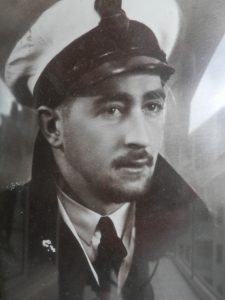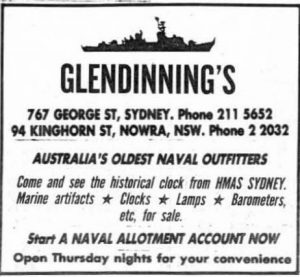- Author
- Editorial Staff
- Subjects
- Biographies and personal histories
- Tags
-
- RAN Ships
- None noted.
- Publication
- June 2015 edition of the Naval Historical Review (all rights reserved)
Most members of the RAN past and present will have set foot in a Glendinning store but where does the name come from? This small tribute has been compiled with assistance from Beverley Noble, George King, Colin Ambrosoli and Dennis Stokes.
Alfred (Fred) Glendinning was born in the Melbourne suburb of East Malvern on 7 February 1918. He was schooled in Melbourne and as a tall athletic sportsman played Aussie Rules for Carlton. His father was a postmaster on the Mornington Peninsula and for a time Fred worked as a postal clerk. But at age 21, and with the excitement of war clouds looming, he enlisted in the RAN on 28 March 1939. His first posting was to HMAS Cerberus as a Probationary Writer.
Unusually, Fred’s first sea posting was to the Armed Merchant Cruiser HMS Arawa, then serving on the East Indies Station. Arawa was built as the Australian Government passenger-cargo liner Esperance Bay which together with her sisters was sold in 1936 to British shipping interests. In her he was promoted Leading Writer and when the ship returned to England to take up trooping he was posted ashore for a short period to the London Depot. Next were postings to the ‘N’ class destroyers HMA Ships Napier and Nepal and the ‘Q’ class HMAS Quiberon. Fred’s career was obviously colourful as in August 1942 he was dis-rated to Writer and lost his Good Conduct Badge but in February 1943 he was back to his rank of Leading Writer. Finally in May 1943 he came ashore to HMAS Rushcutter where he was promoted Petty Officer Writer.

With the end of the war there was still much to be done in bringing the troops back home, transferring occupation forces to Japan and helping with the flood of refugees who needed to be relocated. The Landing Ship Infantry HMAS Manoora was suited to this work and Fred served in her for nearly two years, until the end of 1947. Next came a succession of postings to various Sydney based shore establishments with promotion to Chief Petty Officer Writer in 1949. The end of permanent naval service came in July 1951 when Fred was discharged ashore to begin another chapter in his long association with the RAN.
Fred was always popular with his messmates and something of a larrikin, with a flair for business. While Manoora operated in the Pacific Islands he brought back bags of cultured pearls which were sold at a large profit, and another of his more memorable escapades was the acquisition of two discarded, but almost brand new, American Army jeeps. Fred had the foresight to donate one of these to the ship’s Commander and then there was no trouble getting them onboard where they were re-painted in pusser’s grey with RAN emblazoned on the sides. In Sydney, Fred’s jeep was hoisted ashore and he drove it off through the dockyard gates with a friendly wave to the duty Naval Policeman – the jeep needless to say was sold for a handsome profit.
But what was Fred to do in civvy street, not that he was short of ideas, after all he had to look after his weekend job as a SP bookie. But there had to be other more legitimate opportunities using his navy skills and contacts, then came a flash of brilliance. At that time sailors had to proceed ashore in uniform but with plenty of money in their pockets they could not wait to change into civvies. But where could they find the type of attire needed to provide a smart appearance. Enter Glendenning and Stacey, Naval Outfitters. Fred may have found inspiration from his sojourn in England, where it was Bernards for sailors and Gieves for officers, a near monopoly as non-government suppliers of naval uniforms. A trip to the former was almost a rite of passage for a tiddly cap, with a slight upward fore and aft sweep.
Fred was always a sharp dresser but knew little of tailoring. However the technical colleges were then offering short courses to ex-servicemen to enter business. Not that this sort of craft appealed directly to Fred but he managed to persuade his mate and ex-stoker Ernest (Ernie) Stacey to take a tailoring course, at which he excelled. Fred went to work for Seagraves who were then the main naval outfitters in Sydney. Seagraves was not particularly well run and Fred spied an opportunity for improvements. Fred and Ernie first bought an existing small gentlemen’s outfitters in Sydney’s up-market Macquarie Place and for a while worked there from an upstairs room, learning the ropes. Not long afterwards they rebadged the business as naval outfitters and opened as Glendinning and Stacey.
It was soon apparent that they were in the wrong part of town and needed to be closer to where customers would pass by – so they moved to new premises at 208 George Street between Wynyard Station and the Quay. Royal Naval House was just down the road and at this stage the whole area with its pubs was a stamping ground for sailors. The nearby Ship Inn became Fred’s favourite watering hole. With growing business an agency was established at HMAS Cerberus which survives to this day.
This business proved a great success with sailors readily accepting smart new suits and jumpers. It was not until 1967 with the anti-Vietnam movement that sailors were allowed ashore in civvies. Prior to this many customers would arrive at the shop in uniform and purchase civvies complete for a run ashore, leaving their uniforms to be picked up later. While Glendinning’s provided items of uniform and carried out alterations they did not have the expertise to tailor square rig uniforms, which were contracted out to a wholesale manufacturing tailoring business run by Fred Ambrosoli. A new entrant to the market was Red Anchor, first owned by Stan Phillips and later by Kevin James, who opened a naval outfitter’s at Macleay Street, Potts Point near HMAS Kuttabul with a branch at Cerberus. This unwanted competition was bought out by Glendinning’s in the late 1970s.
One of their customers was the eminent marine artist John Allcot; he was very short of stature and his clothes had to be shortened, otherwise his sleeves became covered in paint. This led to a new awakening and Fred started collecting works of art which were frequently on display in the shop. The wheel of fortune had turned full circle as for a time the ex-captain’s secretary could now count a retired four ring captain amongst his staff.

Tired of paying rent, Fred looked around to buy his own premises and with ever an eye for a bargain he acquired an ex-brothel, near Central Station, which had been fire damaged. George King, another ex-matelot mate, had entered the building trade and was called upon for advice; George assured him they could disguise the blackened mess and gaping holes by leaving well alone and covering it all with plasterboard and paint. George also remembers that Fred had acquired at auction a clock from HMAS Sydney, most likely a wardroom fitting, for which he paid the princely sum of $5,000. George, who had become a collector of clocks, took a fancy to this and after several years Fred sold it to him at mate’s rates, discounted to $4,900.
The business eventually passed into the hands of Colin Ambrosoli (son of the wholesale tailor) who at age 18 started working for Fred. However it continued on under the singular name of Glendinning’s. Fred now concentrated on the life of a gentleman with plentiful time for bowls, golf and fishing. He was happily married to Jean and they had two children. Some time after Jean died Beverley Noble, a delightful young widow, became Fred’s partner and although never married, they lived together for 16 years until Fred’s death in October 2003 at age 85. Amongst Beverley’s mementoes is one of Fred’s favourite pictures – a fine early oil painting of HMAS Sydney by John Allcot.
In the late 1980s Dennis Stokes (a Leading Seaman – Underwater Weapons) when still in the navy gained some casual work with Glendinning’s and when he left the RAN this became a full-time occupation. With plenty of on-the-job experience and a love for the work, in 1993 Dennis bought the business from Colin Ambrosoli. Passers-by will note the famous Glendinning’s sign above a shopfront along Cowper Wharf Road at Woolloomooloo just outside the Garden Island Naval Base and there are branches of the business in Cairns, at HMAS Cerberus and in Rockingham, W.A.
Perhaps these are a fitting tribute to Fred, the character who made the most of opportunities and brought a little sunshine into the lives of those who knew him.




